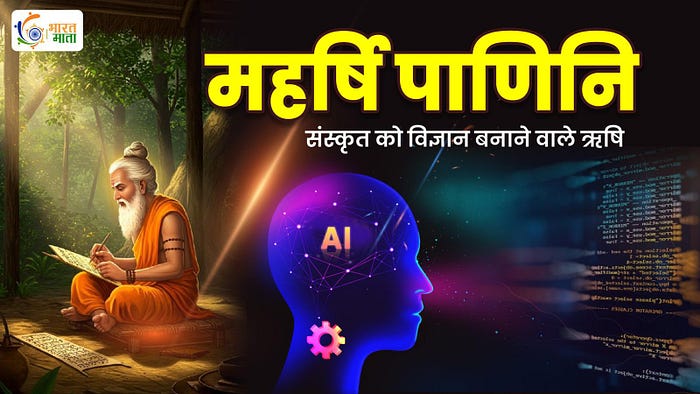Introduction:
In our society and culture, there are some personalities whose contributions are felt not only in their time but also by generations to come. One such unique sage whose name is written in golden letters in the history of Indian linguistics is Rishi Panini. Panini not only understood and systematized the structural foundation of the Sanskrit language but also became an inspiration for modern linguistics. He laid the foundation of grammar and linguistics, which has been respected not only in India but across the world.

Life and Work of Rishi Panini:
Rishi Panini was born between the 4th and 6th century BCE in northwestern India (now the region of Pakistan). Much of the information we have about Panini comes from his works, as he did not leave any written account of his life or personal details. His work “Ashtadhyayi” is a highly significant text of Sanskrit grammar, which organizes all aspects of Sanskrit grammar through almost 4000 sutras (aphorisms).
“Ashtadhyayi” is a unique work on the grammar of the Sanskrit language, in which the rules of spelling, morphology, pronunciation, word formation, and usage are explained in great detail. This text has not only become a guide for linguists but has also inspired mathematicians and computer scientists. Panini’s work was so influential that it was included in the “Vedanga” and is considered essential in various fields of Indian knowledge, including religion and Sanskrit.
Significance of Ashtadhyayi:
Rishi Panini systematized Sanskrit grammar in such a subtle and organized manner that it impacted even the foundations of modern linguistics and mathematical theories. The “Ashtadhyayi” consists of eight chapters, each divided into four sections, with each section containing about 32 sutras. These sutras explain the formation, form, pronunciation, and grammatical structure of Sanskrit words. The rules and sutras given by Panini help not only in understanding the structure of language but also prove useful in calculations and other complex theories.
Panini’s sutras were so scientific that they were later appreciated by European scholars. In the 19th century, when Western linguists studied Panini’s work, they compared it to mathematical formulas, considering it a great achievement. For this reason, Panini was honored with the titles “Father of Linguistics” and “Father of Grammar.”
Shiva Sutra and Panini’s Divine Vision:
The basic sounds and phonemes used by Panini in his works are believed to have been received through the grace of Lord Shiva. It is said that Panini gained divine vision for his work when Lord Shiva, during his Tandava dance, imparted sounds to him from his Damru (drum). Panini incorporated these sounds into his compositions, organizing the structure of the Sanskrit language. This work of Panini is so powerful and lasting that even today it remains an unparalleled reference for students and scholars of Sanskrit.
Sanskrit and Modern Technology:
Panini’s grammar is not only significant from a religious and cultural perspective but has also proven valuable for modern science and technology. Today, Sanskrit grammar is being utilized in fields like computer programming and artificial intelligence (AI). Specifically, Panini’s grammatical rules have guided computer scientists in the field of “Natural Language Processing” (NLP). This is evident in discussions where Sanskrit is considered as a “programming language.”
Panini’s Legacy:
The Sanskrit language, as established by Panini, remains the foundation for many Indian languages today. Most of the languages spoken in India still use words and sounds derived from Sanskrit. These foundational sounds and grammatical rules of Sanskrit have aided the development of Indian languages. The study of texts like the Vedas, Upanishads, and the Bhagavad Gita would not be possible without Panini’s grammar.
In today’s era, when Sanskrit is often considered an ancient and dying language, there is a need to revive Panini’s work. Studying Sanskrit not only deepens our understanding of our cultural heritage but also contributes significantly to modern linguistics, mathematics, and computer science.
Conclusion:
Rishi Panini is a priceless gem of Indian culture. His contributions are appreciated not only in the context of Indian languages but also in the global fields of linguistics, mathematics, and science. Even today, his work “Ashtadhyayi” stands as an enduring legacy, serving as a steadfast and vital guide in the study of language and literature. Panini’s work teaches us that the study of language is not just a tool for communication, but it also influences the way we think, understand, and analyze the world.
To learn more about other great sages born on this holy land, subscribe to the Bharat Mata Channel.
Comments
Post a Comment